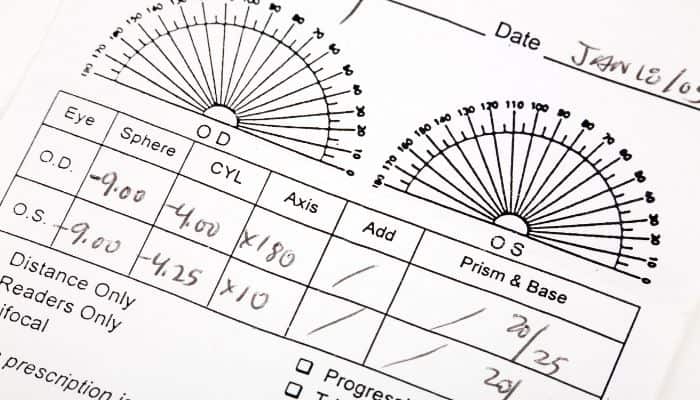If you’ve ever gotten a glasses prescription, seeing “CYL” on it may be confusing.
Simply put, CYL is short for ‘cylinder,’ which is a term that indicates the amount of astigmatism in your eye.
While it may sound complex, it’s actually a key factor in understanding your vision and getting the right eyewear to correct it.
(This page contains affiliate links. OGR may receive compensation if you click a link and make a purchase.)
What is Astigmatism and How Does It Affect Your Vision?
Astigmatism, a somewhat fancy term for a common visual condition, affects approximately one in every three individuals worldwide. That’s a lot of folks! But what exactly is it?
At its core, astigmatism is a refractive error. “Refractive” here refers to how the eye bends or refracts light. This error is due to an irregular or non-spherical shape of the cornea, the outer front surface of your eye.

Think of it like this: ideally, your cornea should be shaped like a basketball, but in the case of astigmatism, it’s actually shaped more like a football.
Despite the sound of it, there’s no cause for alarm. Astigmatism isn’t a disease or an eye health problem; it’s more of a quirk in how your eye focuses light onto the retina—the inner layer at the back of your eye that senses light and helps you see.
In a perfectly spherical cornea, light entering the eye gets refracted, or focused, uniformly, creating a single focal point within the eye.
However, in an astigmatic eye, this process gets a little skewed. Because of the irregular corneal shape, light has two different refracting powers, leading to two focal points within the eye.
This double focus is what muddles your visual clarity.
Most people with astigmatism also have either myopia (nearsightedness) or hyperopia (farsightedness) – additional refractive errors that influence how they see the world.
In a nutshell, while astigmatism might complicate your vision a bit, it’s not something to worry about. The right pair of glasses or contacts can easily correct it.
The Nitty-Gritty: How is CYL Measured?
CYL is measured in diopters, which are a unit of measurement that tells us the optical power of a lens. When it comes to diopters, the higher the number, the stronger the lens.
Making Sense of CYL on a Glasses Prescription

In simple terms, the CYL column is your cheat sheet to understanding how much correction for astigmatism you need.
The number that follows CYL on your prescription is often accompanied by a minus (-) sign for nearsighted astigmatism or a plus (+) sign for farsighted astigmatism.
It’s not just random symbols; each gives you crucial info about the type of astigmatism correction you need.
For instance, let’s look at a prescription that reads
SPH -2.00 CYL -1.00 AXIS 180
What this means is that you require a lens with -2.00 diopters of sphere power (that’s the spherical correction needed) and -1.00 diopters of cylinder power (your astigmatism correction).
As for the “AXIS 180” part, it’s basically telling your eye doctor the direction in which the cylinder power should be applied.
What is Axis In A Glasses Prescription?
Examples of Glasses Prescriptions For Different Types and Degrees of Astigmatism

There are three primary types of astigmatism – myopic, hyperopic and mixed. The myopic and hyperopic types are further divided into simple and compound categories:
Simple Myopic Astigmatism
Simple myopic astigmatism is when one meridian (or focal line) of the eye is nearsighted (myopic), while the other is not refracted, meaning it doesn’t need any correction. So, part of your vision is clear while the other part is blurry.
An example of a prescription for simple myopic astigmatism could be:
SPH 0.00 CYL -1.50 AXIS 90
Here, the sphere power is zero (indicating no correction needed for that meridian), but the cylinder power of -1.50 diopters signifies that nearsighted astigmatism correction is required.
Compound Myopic Astigmatism
Compound myopic astigmatism occurs when both meridians of the eye are nearsighted, but to different degrees, causing blurred vision at all distances.
An example of a prescription for compound myopic astigmatism could be:
SPH -2.00 CYL -1.00 AXIS 180
This means that both meridians require correction for nearsightedness, but the correction amounts needed differ.
Simple Hyperopic Astigmatism
Simple hyperopic astigmatism is the flip side of the coin. In this case, one meridian is farsighted (hyperopic), while the other is not refracted.
An example of a prescription for simple hyperopic astigmatism is:
SPH 0.00 CYL +2.00 AXIS 180
Here, the zero sphere power shows that no correction is needed in one direction, but the cylinder power of +2.00 diopters indicates that a correction for farsighted astigmatism is needed in the other direction.
Compound Hyperopic Astigmatism
Compound hyperopic astigmatism is when both meridians of the eye are farsighted but to varying degrees, causing vision issues at all distances.
An example of a prescription for compound hyperopic astigmatism might read:
SPH +2.00 CYL +1.00 AXIS 90
Mixed Astigmatism
Last but not least, we have mixed astigmatism, where one meridian is nearsighted, and the other is farsighted.
An example of a prescription for mixed astigmatism could look like this:
SPH -1.00 CYL +2.00 AXIS 180
This means one meridian requires correction for nearsightedness, while the other requires correction for farsightedness.
How To Read Your Eyeglass Prescription
FAQs
What’s the Difference Between CYL and SPH on My Prescription?
SPH (short for sphere) and CYL (short for cylinder) are two distinct measurements on your glasses prescription, tackling different aspects of your eye’s refractive abilities.
SPH zeroes in on the level of your nearsightedness or farsightedness, while CYL addresses the degree of astigmatism.
Can I Wear Contact Lenses Instead of Glasses If I Have Astigmatism?
Certainly! Contact lenses designed to correct astigmatism can be an excellent alternative to glasses.
However, remember that you’ll need a different prescription—contacts and glasses aren’t a one-prescription-fits-all deal.
The world of astigmatism-friendly contact lenses is broad, including options like toric, multifocal, or hybrid lenses.
While contacts offer perks like improved peripheral vision, greater freedom for movement, and compatibility with certain jobs or sports, they do have a few downsides.
They demand regular maintenance, can potentially raise your risk of eye infections, may cause discomfort or dry eyes, and their replacement frequency usually make them pricier than glasses.
Can I Have Astigmatism But No CYL Value on My Prescription?
Yes, some people may have mild or borderline astigmatism that does not require CYL correction on their prescription. However, this may change over time as your eyes age or your vision changes.
Can I Have a CYL Value But No SPH on My Prescription?
Yes, it is possible for some people to have pure astigmatism without a spherical refractive error. However, this is rare and typically occurs in children or young adults.